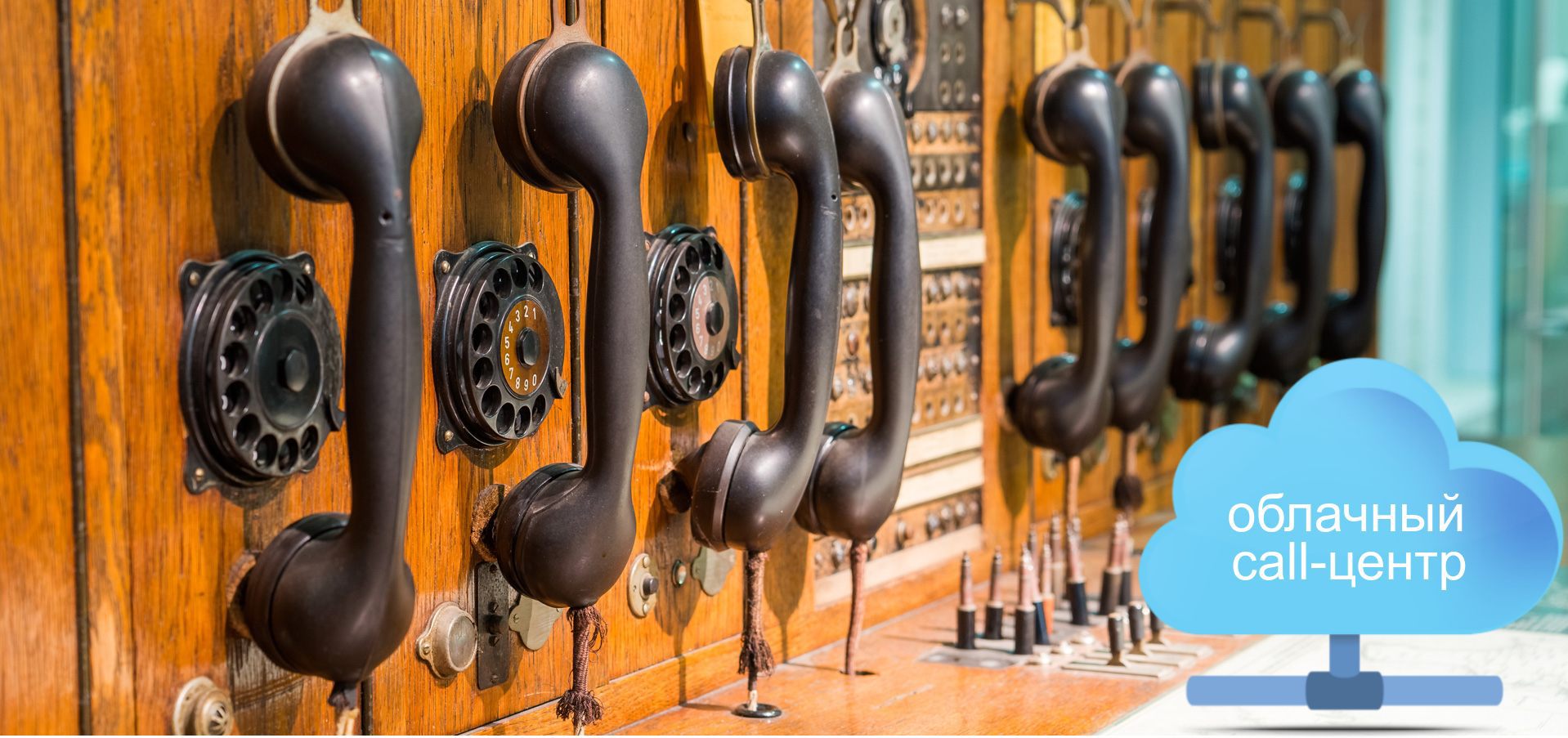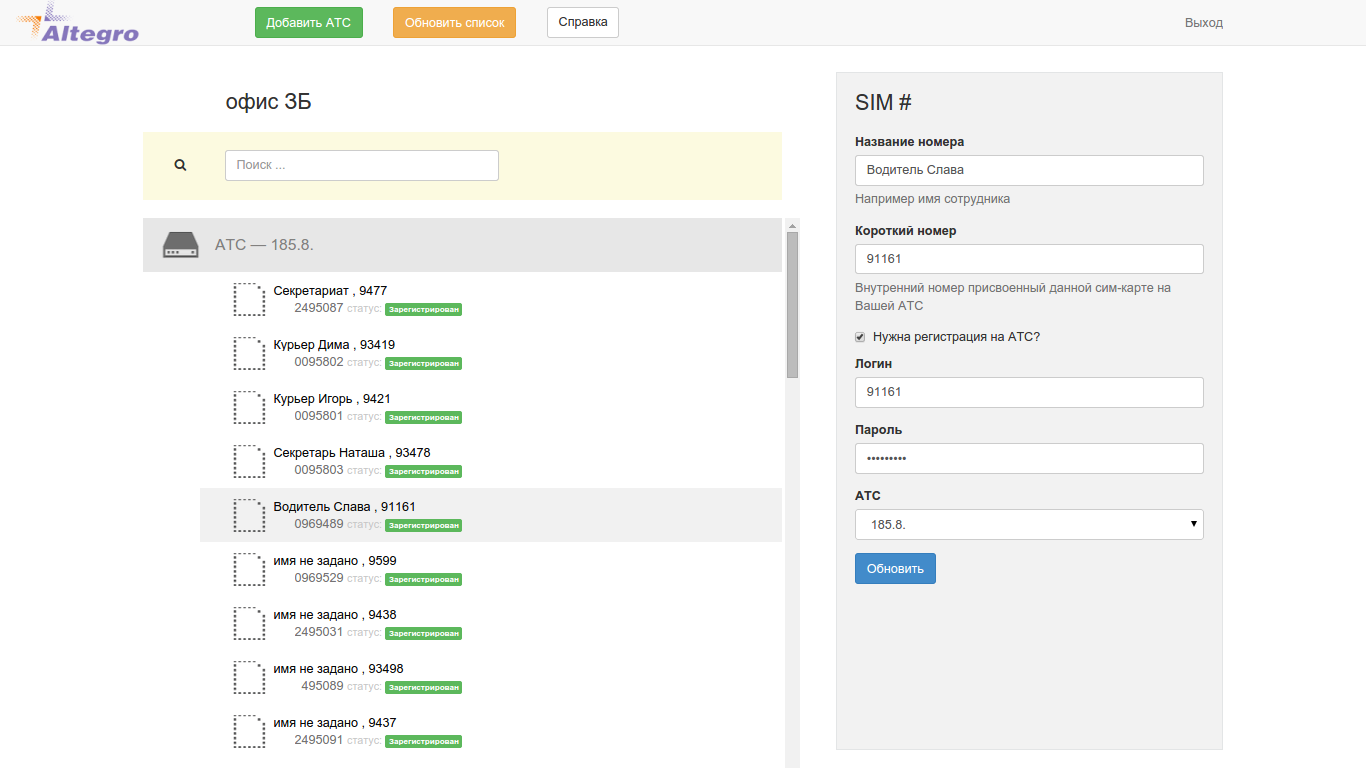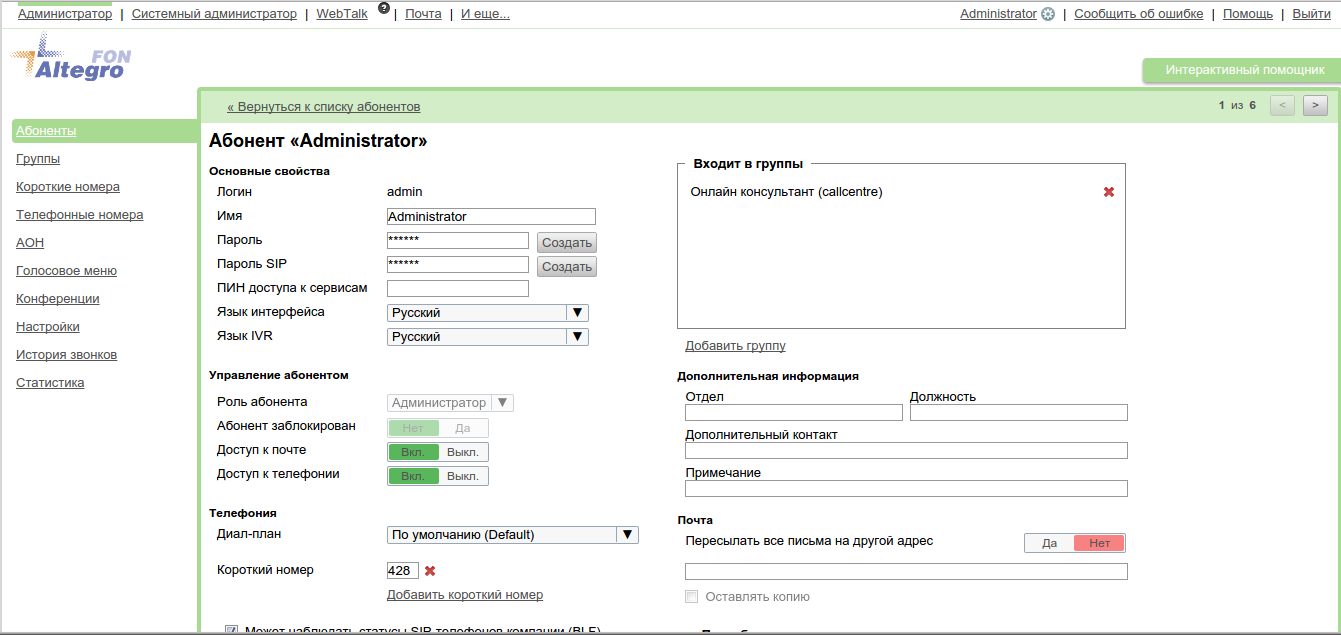Sell in 60 seconds. Call center in the cloud and a special SIM card
There are a lot written about call centers, cloudy, cloudless and transcendental, and everyone who undertakes to issue “another cool material about a cloud call center” to the mountain almost certainly asks the question - “why would you invent such a thing to look better than your competitors Honestly, when writing this hub, we were puzzled by exactly the same, but doubts did not last long, because at least one “killer feature” we still have is a close and sophisticated integration of VoIP technology and corporate mobile communication . In addition, our cloud PBX AltegroCloud itself is a rather curious product, if only because at the project design stage, we decided not to use the server with a free Asterisk inside the blinking LEDs and not only because of the free cheese, but also in a number technological and ideological reasons. Sometimes it's better when others work for you, and you just pay for the work, but the work is done efficiently and on time. From the point of view of operation, the platform from a reputable vendor, albeit a paid one, is always better than a thoroughbred, even purebred, open source.

In previous publications, we have a lot, for a long time and sometimes tediously described ready cases for real estate agencies, told how using our platform and AltegroSIM special SIM cards to create a crystal-fair robot seller, and to record all conversations from mobiles, track and monitor and in addition attach to card deals in almost any CRM system. Each such decision is manual work, tears and sweat of programmers and sleepless nights of customers. This is both good and bad at the same time - each hand-made project is undoubtedly a source of pride, but the subject of pride has one significant drawback - it is not replicable, i.e. it will never become an IT-hamburger from McDonalds, the sale of which can be put on stream, blame yourself on one of the islands of the Gulf of Thailand to drink a smoothie.
')
It is clear that the idea of an IT-hamburger is good in almost everything and we also wanted to implement it, especially since the vendor provided all the necessary tools for free. Thus, we have two cloudes - regular and advanced, which is cloudy, which is integrated with mobile communications.
The work scheme of any call center, if not immersed in details and specifics, looks about the same. True, in our case, the “killer feature” is added - integration with mobile communication: it seems to be a normal call center, but the mobile phones of employees with our SIM cards work just like office, fixed, operators' phones.

Now it is possible to combine common scenarios of female operators, delivery service on mobile and stern management, record all transaction data, including negotiations from mobile, in CRM, track the geography of employees and record conversations of customers and managers from cell phones. It all works almost immediately, out of the box, after 10-15 mouse clicks on the "Next" button.
The first mouse click falls on the “Allow FMC” button in the admin panel of our PBX. This button includes the integration of mobile communication and IP-PBX, now the mobile phone is represented by a telephone station as a regular telephone.

A mobile phone can be assigned as an internal PBX line and processed by all the usual scenarios - voice menus, call centers, will be included in the statistics and can be recorded like any other conversation. At the same time, it will not be a redirect, for which you will have to pay, but an absolutely full-fledged Internet call broadcasting to a GSM network with the transfer of all numbers and the caller ID of your company, i.e., an advertising number.
We start employees as usual and assign them short numbers - this is simple, easy and understandable.

At this stage, we already know which employees will use the communication on mobile phones (for example, the same couriers who call customers or call center operators at home) and set up SIM cards as internal lines of our PBX, simply by assigning them short numbers in a special interface. That's all, Simka has become an ordinary sip-phone, but with legs.

We create the right groups, for example, a group of employees who receive calls from customers, but periodically run away “to smoke” and we cannot influence this much, but we can send the call directly to the mobile phone if they are not at the workplace, and save the call itself , write and process.

Our mobile employees, Anna Vladimirovna and Oleg Petrovich, wherever they are, are always in touch by a single internal number and if they decide to call the client back from the cell phone, then the outgoing number will determine the company’s number, and the boss will know when and by whom the fatal call, which increased the company's profitability fifteen times and brought it to the Forbes Top-10 list, with subsequent bonus accrual, of course.
In addition to the fact that we can record calls from mobile phones, see them in the statistics and manage them as usual calls, we can “hang” cool call center functionality, for example, waiting queues. Two mouse clicks on the desired buttons and ready.

Now, with a large number of incoming calls, calls can be distributed to mobile workers according to the usual rules of the PBX, without any amendments to the specifics of the cellular network and forwarding. Operator Anna Vladimirovna, for three months now she has been living at the country house of the aunt, the aunt does not have a “normal” Internet, and Anna continues to work as usual, simply using our SIM card as a work phone. Anna’s boss in the office in Moscow listens carefully to her conversations with customers and puts the necessary notes in the CPM, sees reports. Everyone is happy, including Anna Vladimirovna herself, who took the child to the dacha and works by the window overlooking the flowering meadow in the very heart of the middle Russian plain.
In a completely analogous manner, if necessary, we can connect Anna Vladimirovna to the outgoing calls, let it continue to work, since the stake has already chosen the difficult fate of the call center operator at home.
Two more mouse clicks create an outgoing company in the platform interface

Now, the remote Anna Vladimirovna accepts incoming calls, sees customer numbers, changes her status “online-not online”, incoming calls to her are processed by call center scenarios, and in general Anna does everything that her friend Tatyana Alekseevna does from the office. We remind you that Anna uses a regular mobile phone for calls and a slow 3G connection, and only for working in a CRM system.
It remains to add to our cocktail of mobile-convergent technologies the last and final touch - routing the incoming call to the responsible manager. One more click and ready - our cloud can do it right out of the box.

Having done all of the above, the procedures finally get a cloud call center integrated with mobile communications. In many cases, this integration will help solve a number of specific problems: easy connection of mobile employees (home operators without a full Internet, as a vivid example), courier service, answering customer calls using a single company number and making calls from the same number, just mega-active managers Sales, actively moving around the office.
Description of other cases that can be “clicked” in our cloud in 60 seconds in the following hubs.
To be continued…

In previous publications, we have a lot, for a long time and sometimes tediously described ready cases for real estate agencies, told how using our platform and AltegroSIM special SIM cards to create a crystal-fair robot seller, and to record all conversations from mobiles, track and monitor and in addition attach to card deals in almost any CRM system. Each such decision is manual work, tears and sweat of programmers and sleepless nights of customers. This is both good and bad at the same time - each hand-made project is undoubtedly a source of pride, but the subject of pride has one significant drawback - it is not replicable, i.e. it will never become an IT-hamburger from McDonalds, the sale of which can be put on stream, blame yourself on one of the islands of the Gulf of Thailand to drink a smoothie.
')
It is clear that the idea of an IT-hamburger is good in almost everything and we also wanted to implement it, especially since the vendor provided all the necessary tools for free. Thus, we have two cloudes - regular and advanced, which is cloudy, which is integrated with mobile communications.
The work scheme of any call center, if not immersed in details and specifics, looks about the same. True, in our case, the “killer feature” is added - integration with mobile communication: it seems to be a normal call center, but the mobile phones of employees with our SIM cards work just like office, fixed, operators' phones.

Now it is possible to combine common scenarios of female operators, delivery service on mobile and stern management, record all transaction data, including negotiations from mobile, in CRM, track the geography of employees and record conversations of customers and managers from cell phones. It all works almost immediately, out of the box, after 10-15 mouse clicks on the "Next" button.
The first mouse click falls on the “Allow FMC” button in the admin panel of our PBX. This button includes the integration of mobile communication and IP-PBX, now the mobile phone is represented by a telephone station as a regular telephone.

A mobile phone can be assigned as an internal PBX line and processed by all the usual scenarios - voice menus, call centers, will be included in the statistics and can be recorded like any other conversation. At the same time, it will not be a redirect, for which you will have to pay, but an absolutely full-fledged Internet call broadcasting to a GSM network with the transfer of all numbers and the caller ID of your company, i.e., an advertising number.
We start employees as usual and assign them short numbers - this is simple, easy and understandable.

At this stage, we already know which employees will use the communication on mobile phones (for example, the same couriers who call customers or call center operators at home) and set up SIM cards as internal lines of our PBX, simply by assigning them short numbers in a special interface. That's all, Simka has become an ordinary sip-phone, but with legs.

We create the right groups, for example, a group of employees who receive calls from customers, but periodically run away “to smoke” and we cannot influence this much, but we can send the call directly to the mobile phone if they are not at the workplace, and save the call itself , write and process.

Our mobile employees, Anna Vladimirovna and Oleg Petrovich, wherever they are, are always in touch by a single internal number and if they decide to call the client back from the cell phone, then the outgoing number will determine the company’s number, and the boss will know when and by whom the fatal call, which increased the company's profitability fifteen times and brought it to the Forbes Top-10 list, with subsequent bonus accrual, of course.
In addition to the fact that we can record calls from mobile phones, see them in the statistics and manage them as usual calls, we can “hang” cool call center functionality, for example, waiting queues. Two mouse clicks on the desired buttons and ready.

Now, with a large number of incoming calls, calls can be distributed to mobile workers according to the usual rules of the PBX, without any amendments to the specifics of the cellular network and forwarding. Operator Anna Vladimirovna, for three months now she has been living at the country house of the aunt, the aunt does not have a “normal” Internet, and Anna continues to work as usual, simply using our SIM card as a work phone. Anna’s boss in the office in Moscow listens carefully to her conversations with customers and puts the necessary notes in the CPM, sees reports. Everyone is happy, including Anna Vladimirovna herself, who took the child to the dacha and works by the window overlooking the flowering meadow in the very heart of the middle Russian plain.
In a completely analogous manner, if necessary, we can connect Anna Vladimirovna to the outgoing calls, let it continue to work, since the stake has already chosen the difficult fate of the call center operator at home.
Two more mouse clicks create an outgoing company in the platform interface

Now, the remote Anna Vladimirovna accepts incoming calls, sees customer numbers, changes her status “online-not online”, incoming calls to her are processed by call center scenarios, and in general Anna does everything that her friend Tatyana Alekseevna does from the office. We remind you that Anna uses a regular mobile phone for calls and a slow 3G connection, and only for working in a CRM system.
It remains to add to our cocktail of mobile-convergent technologies the last and final touch - routing the incoming call to the responsible manager. One more click and ready - our cloud can do it right out of the box.

Having done all of the above, the procedures finally get a cloud call center integrated with mobile communications. In many cases, this integration will help solve a number of specific problems: easy connection of mobile employees (home operators without a full Internet, as a vivid example), courier service, answering customer calls using a single company number and making calls from the same number, just mega-active managers Sales, actively moving around the office.
Description of other cases that can be “clicked” in our cloud in 60 seconds in the following hubs.
To be continued…
Source: https://habr.com/ru/post/266003/
All Articles